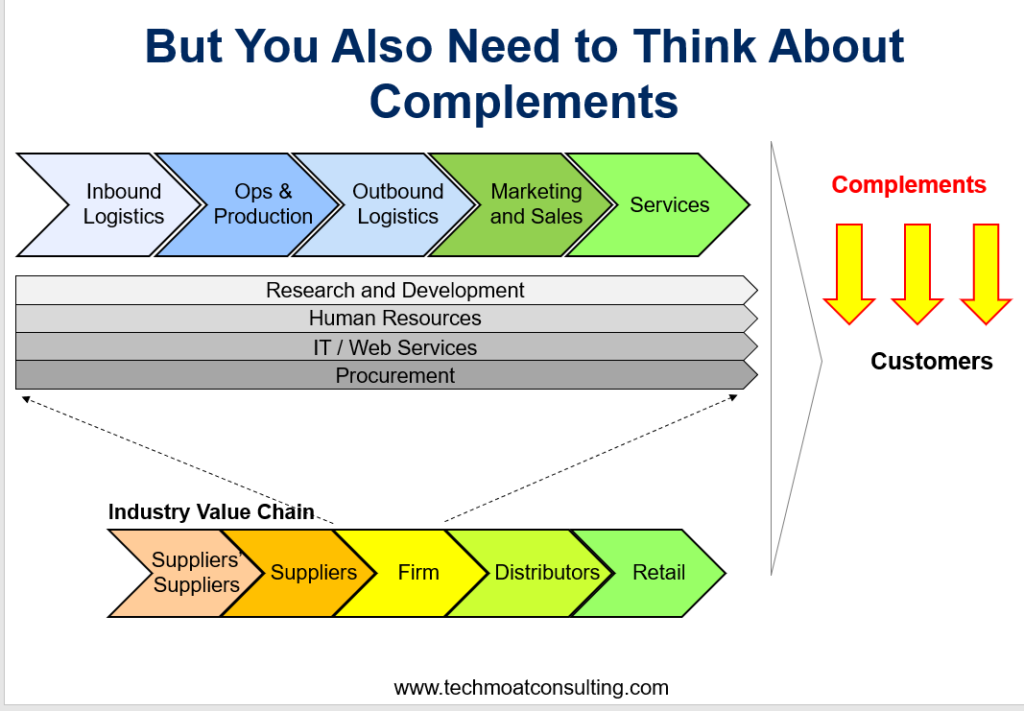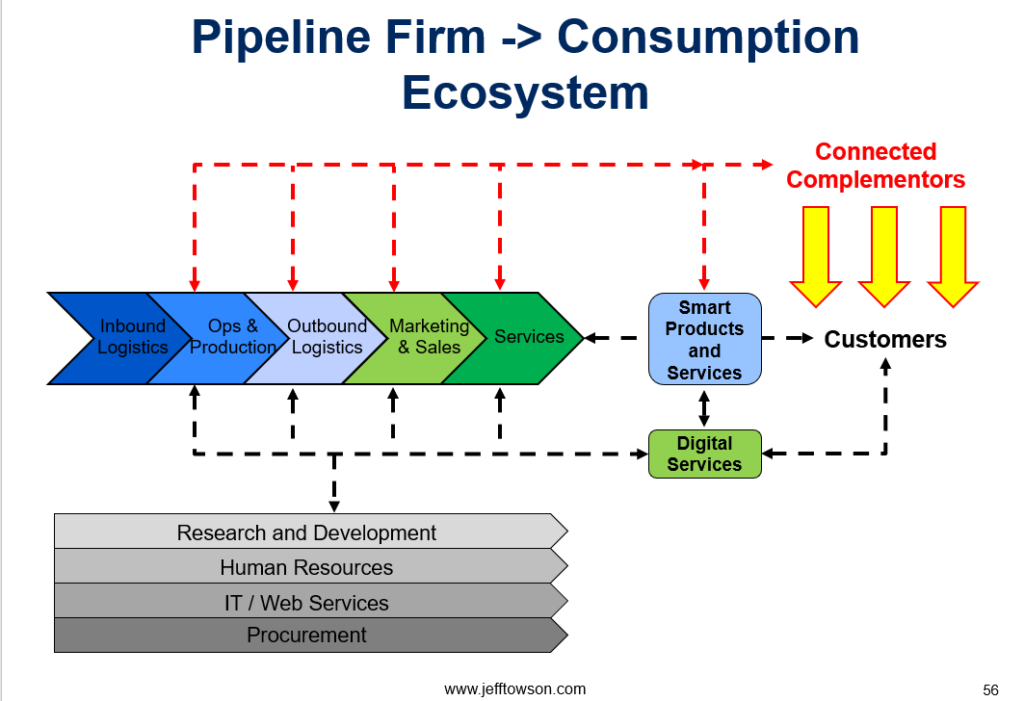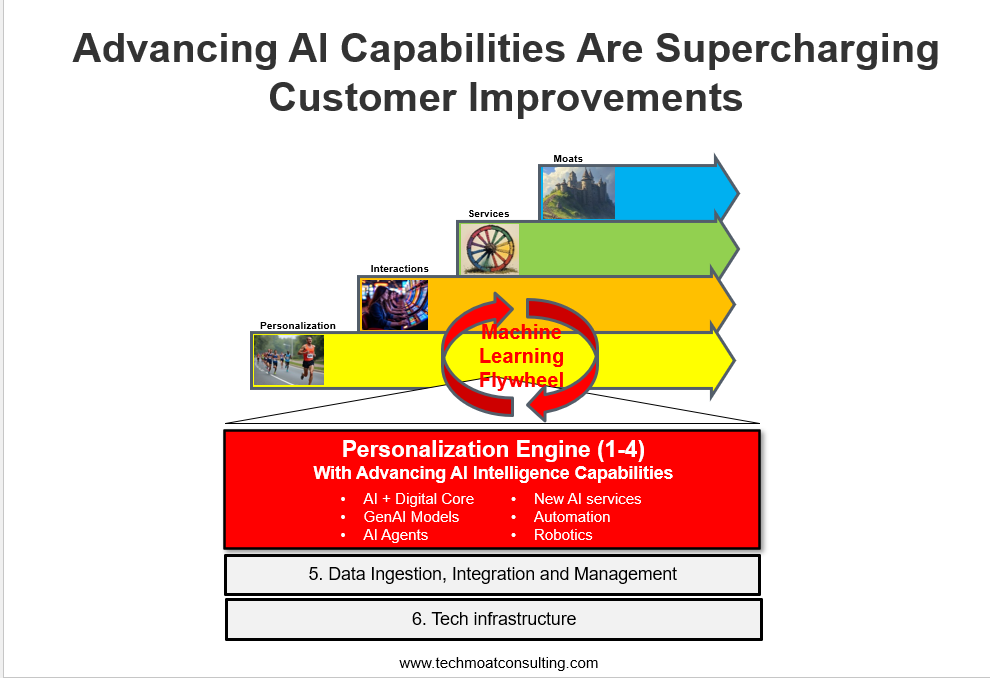I’ve gone through the first two levels of the Extreme Personalization Playbook (PrISM).
- P – Increased Personalization; Run a Personalization Marathon
- I – Improved Interactions – Build a Repeat and Retain Machine
Which brings me to:
New Services – Surround Your Customers with Ever-Increasing Value
This is mostly about adding services, especially complements. It’s about going beyond your core. You surround your customers with additional value-added services over time. Is is the s in PrISM.

I view this as a wagon wheel, with the customer at the center. You keep adding spokes that provide additional value. And this process keeps going as you surround your customers with ever-increasing value.

That is not a great visual. If you have suggestions, I’d appreciate it.
The company that always comes to mind for this is Alibaba. Their core strategy has always been to add increasing value to their customers. This is how they stay ahead of constantly attacking digital competitors. Their network effects also help.
For example, here are the services that Alibaba provides to its ecommerce merchants and brands. They have created a list of services based on the P&L of a typical merchant.

Alibaba’s list of such services is impressive.
- Payments (Alipay)
- Logistics (Cainiao)
- Marketing. Uni-Marketing is the service where Alibaba provides a data-rich dashboard for merchants to see the behavior of their current and potential customers.
- Supplier and consumer credit offerings of Ant Group.
- The data intelligence and expanding services of Alibaba Cloud.
- The Tmall Innovation Center (TMIC) which helps merchants study their customers and create new products in record time. I’ll get back to this in a second.
Most of these services are grow revenue (i.e., margin products). But they are also about creating other types of value for their customers. These services can also be important for increasing engagement (i.e., engagement products). You want to think about how value can translate into engagement vs. margin products.
Another good example is Trip.com, the Chinese global online travel agent. Here is how they describe themselves in their SEC filings. Note the sentence “we have evolved from an emerging travel transaction platform to a one-stop travel platform integrating a comprehensive suite of travel products and services and differentiated travel content.”

And they have accomplished this by growing their own brands, doing acquisitions and making strategic partnerships.

Increasing Complements and Services Leads to Cross-Selling, Up-Selling and Bundling
The most common type of added value is complements. Keep in mind, most firms provide only part of a customer solution. They then often coordinate with complements for the rest of the solution. For example, hot dog sellers coordinate with bun sellers.
When adding value with new services, you really want to expand into complements and directly related services as much as possible. You want to solve more of the same problem. After that you can add services to unrelated problems.
For a linear business model, I usually show complementary services like this.

I’ve talked this recently in the Digital Attacker Strategy.
That strategy is how a digital attacker (say Expedia or HubSpot) uses a new digital tool to break into a mature industry (often called a wedge). They create a new version of an existing service and capture a strong position with customers. This would be Expedia offering an online flight and hotel reservation service. That is step 1.
But then they start to add services and complements to their core offering. That is Expedia offering train tickets. And local tour guides. They then cross-sell these services. But the real power is when they start offering bundles.
Why is bundling so powerful?
Here’s my standard explanation.
- Bundling can create better services. By adding other services and complements, you can solve more of a customer’s problems. People don’t just want hot dogs. They want hot dogs, buns and mustard. You want to offer as much of the solution to your customer’s real problem as possible. And you want to expand to adjacent problems.
- Bundling can be a barrier to entry. You want to create an offering others can’t easily match (that’s a barrier to entry). The Microsoft Office bundle was hard for Lotus Notes to compete with. They didn’t have an equivalent to Word or PowerPoint.
- Bundling enables subsidies. If you have multiple services, you can subsidize between them. You can make your money in hotdogs and give the buns away cheap. That is devastating to the companies that only sell buns. You can even give stuff away for free just to hurt competitors in a particular area (called “scorching the earth”). Facebook is currently giving away LLMs for free to hurt OpenAI’s profitability in its core business.
Bundling is more powerful in digital goods (think Adobe) than in physical goods (think shampoo). Because these products are more connected. And they have zero marginal production costs.
And we have certain business models that are really good at connecting. Everything I just described becomes more powerful when we start looking at connected business models – such as platform business models like Alibaba.
However, production and consumption ecosystems are far more common.
When you think of offering complements and additional services, you can do that internally or you can do that by partnering with other firms. A consumption ecosystem is a really powerful way to do this. I wrote about them here.

***
And this brings me to my final point. Which is that Levels 1-3 are getting much more powerful with generative AI.
The Personalization Playbook Is Becoming More Powerful with Increased Learning, Intelligence and Adaptation (i.e., GenAI).
That’s why I call it the Extreme Personalization Playbook.
This playbook is the sharp end of the spear in digital strategy. It is all the digital tools and thinking being deployed to increase customers, revenue and engagement as directly as possible.
And it is also where generative AI and intelligence capabilities are making things much more powerful. If you’re going to deploy those tools anywhere, this is the place.
Think about how GenAI and increased intelligence can impact:
- Measuring customer activity and getting customer and business insights.
- Increasingly effective and personalized communications. For deals and promotions. For services and experiences.
- Increasing mechanisms for customer engagement and frequency.
- Building loyalty programs for increased retention.
- Adding new services and complements. More rapidly and targeted than before.
All of this is happening much faster. And it’s better and cheaper.
If personalization is a marathon, here is how I view personalization with GenAI tools. You want to be the guy on the motorcycle.

Think about the Tmall Innovation Center (TMIC), which I mentioned above. That is Alibaba’s service that lets merchants add new products within weeks. Not months and years. Weeks. And at a low cost and with much less risk.
Ctrip is working on a virtual tour assistant. So when you go on your trip (which they have booked), there is a virtual assistant along with you. To advise on things like local activities and attractions. And can offer deals.
They can do this because they can tell a merchant from their data what products are likely to work. And then test them in real-time on their platform. Now imagine this with new AI tools. Suddenly, identifying and launching new complements and services can happen really fast.
Here’s how I view it in terms of data and tech architecture.

And at the center is a Personalization Engine.

Typically, personalization requires data, agile teams and workflows. Which have a flywheel between their usage and effectiveness. This how you take learnings and adapt them into the products.
But now we can add to that much greater learning and intelligence capabilities. This enables things like new AI services, AI Agents, Robotics, etc. There is a new AI tech stack for the personalization playbook.
For those that have been following me, this is all about Rate of Learning, Intelligence and Adaptation. Which I’ve been talking about forever.
And we see lots of new GenAI tools changing this playbook. Automation. Robotics. But the most exciting of these are new foundation models and AI services, many of which are powered by a machine learning feedback loop. AI services is a big new focus of Alibaba.
Finally, keep in mind, that this is ultimately about people. So training, re-skilling and working with partners is also key.

Build a Moat (the M in PrISM)
Finally, there is building a moat. Which I’ve written 8 books about. My standard image for that is a castle (with a moat).

And for moats, we are looking first at demand-side power. Most everything in this personalization playbook has been about strengthening your business on the demand side. With customers. By personalizing. By thrilling them. By surrounding them with increasing value. Well, at the moat level, we call this Share of the Consumer Mind.
However, there are lots of other types of moats (both barriers to entry and competitive advantages).
Put the whole playbook together and we get Level 4, which is on the right. That’s what you want to be as a business. For me, that is the strongest possible position for competing in an age of endless products and services.

Cheers, Jeff
Here are the other Levels.
- Unlock the Secret to Customer Obsession: The Extreme Personalization Playbook (1 of 3) (Tech Strategy)
- Extreme Personalization Playbook Level 2: Build Your Repeat and Retain Machine (2 of 3) (Tech Strategy)
————-
Related articles:
From the Concept Library, concepts for this article are:
- Extreme Personalization Playbook (PrISM): 4 Levels of GenAI Supercharged Customer Improvements
- S – New Services: Surround Your Customers With Ever Increasing Value
From the Company Library, companies for this article are:
- n/a
—––
I am a consultant and keynote speaker on how to increase digital growth and strengthen digital AI moats.
I am the founder of TechMoat Consulting, a consulting firm specialized in how to increase digital growth and strengthen digital AI moats. Get in touch here.
I write about digital growth and digital AI strategy. With 3 best selling books and +2.9M followers on LinkedIn. You can read my writing at the free email below.
Or read my Moats and Marathons book series, a framework for building and measuring competitive advantages in digital businesses.
This content (articles, podcasts, website info) is not investment, legal or tax advice. The information and opinions from me and any guests may be incorrect. The numbers and information may be wrong. The views expressed may no longer be relevant or accurate. This is not investment advice. Investing is risky. Do your own research.
